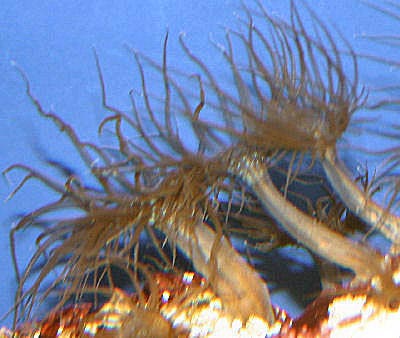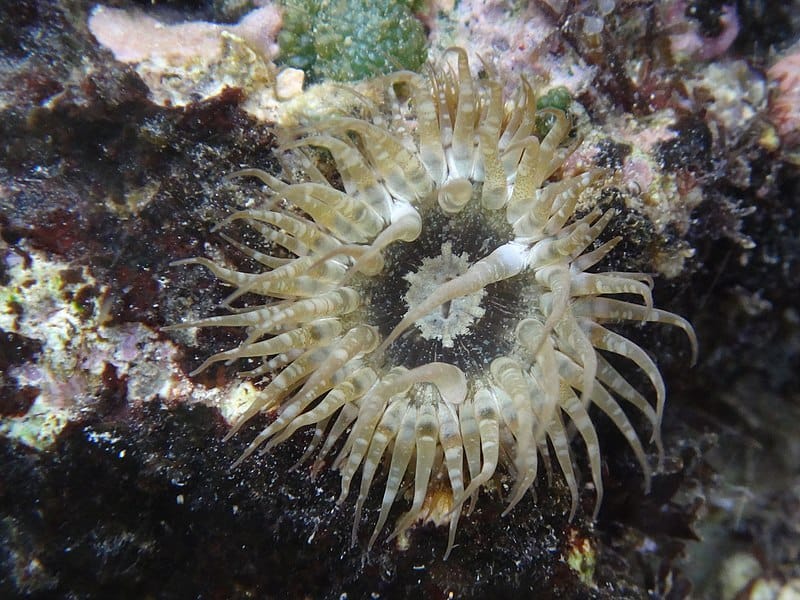
Aiptasia are often called ‘weedy’ anemones! They grow like weeds, take over the reef tank, and are very hard to control!
Aiptasia anemones are considered pests in the marine aquarium hobby. They are usually accidentally imported as hitchhikers on live rock or on the base of corals. None of the Aiptasia species are recommended for any saltwater aquarium system, unless you intentionally want to cultivate them.
When Glass Anemones are introduced into the reef tank they are extremely adaptable and hardy. They can multiply quickly and with their potent sting they can dominate and overrun an aquarium. Once they have a foothold they are notoriously difficult to remove, and attempts to remove them often inadvertently create more.
If you find Aiptasia in your aquarium, you will want to take steps immediately to keep these pest anemones at a minimum. There are a variety of approaches to reduce and control aiptasia populations. These include manual efforts through chemical control and physical control. Biological control is another approach, using natural sea anemone predators.
Unfortunately there is no absolute method of getting rid of glass anemones entirely once this pest has gotten a foothold. Many of the approaches seem to work well, but don’t be surprised if there are traces of anemone left behind. These traces often then regenerate into new anemones, and start to populate the aquarium all over again.
For information about Aiptasia and the pros and cons of
keeping them in captivity, see: Aiptasia Sea Anemone Facts
How Do We Get Aiptasia?
Saltwater hobbyists don’t purchase Aiptasia anemones. Rather the glass anemones are accidentally introduced into a saltwater system as a hitchhiker on live rock, or the come in attached to the base of corals. Also, aquariums where brine shrimp nauplii is provided as a plankton substitute will sometimes end up with aiptasia blooms.
Unless planning to cultivate this anemone, you would not knowingly purchase live rock or corals with aiptasia on it. But because Aiptasia are very small and inconspicuous, they can be difficult to see. When the rock or coral they are attached to is disturbed, they will quickly retract. They can hide inside holes or crevices in the rock for weeks, or even months until aquarium conditions are suitable.
Why are Glass Anemones Harmful?
Though very small, the Glass Anemones have proven quite hardy and durable. They are called the ‘Weedy’ Anemone because they grow like weeds. They have the ability to reproduce rapidly in saltwater aquariums where there are plenty of nutrients and good lighting. Consequently Aiptasia can reach plague proportions in captivity.
The weedy Aiptasia is also an anemone that is able to out compete other species in the reef tank. When disturbed Glass Anemones eject dangerous white stinging threads, or acontia. By using venomous cells or nematocyst found in their tentacles, they sting and push other inhabitants away from their “turf”. They have strong stings that can harm, and even kill other corals and fish.
Sea Anemone Predators
Butterflyfish:
A number of Butterfly fish are known to eat aiptasia. At first take this many seem great, but it may not really work our. There are a number of other factors besides glass anemones that must be considered before adding a Butterflyfish to an aquarium. Be sure to research the Butterflyfish you are considering for diet, environment, and ease of care.
Some Butterflyfish are very difficult to keep, requiring an experienced aquarist. Some can be kept in a saltwater fish aquarium, but must be used more carefully in a reef environment as they may snack on various corals, zoanthids and star polyps, and even feather dusters.
Some Butterflyfish species known to eat Aiptasia include:- Klein’s Butterflyfish Chaetodon kleinii
- Raccoon Butterflyfish Chaetodon lunula
- Copperband Butterflyfish Chelmon rostratus
- Saddled Butterflyfish Chaetodon ephippium
- Threadfin Butterflyfish Chaetodon auriga
- Hawaiian Butterflyfish Chaetodon tinkeri
- Banded Butterflyfish Chaetodon striatus
- Klein’s Butterflyfish Chaetodon kleinii
Filefish:- The Bristle-tail Filefish Acreichthys tomentosus has also been reported to snack on aiptasia anemones. Though it is said to be reef safe, most filefish are not, so use it with caution
- Pufferfish:
Puffers are sometimes known to eat Aiptasia, but they are another saltwater fish that you need to research before putting it in a reef tank. Though they primarily eat fish, they will also snack on a variety of invertebrates. Some Pufferfish that may eat Glass Anemones include:- Guinea Fowl Puffer Arothron meleagris is said to eat aiptasia, but because of its large size is not suitable for many mini reefs.
- Sharpnosed Puffer Canthigaster solandri is a smaller puffer, so could be a good candidate for the reef tank.
- Guinea Fowl Puffer Arothron meleagris is said to eat aiptasia, but because of its large size is not suitable for many mini reefs.
Brackish Water Fish:
Scats in the genus Scatophagidae are brackish water fish that will readily consume Aiptasia Anemones as part of a varied diet.- Spotted Scat Scatophagus argus are quite hardy and can be acclimated successfully to both fresh water and saltwater aquariums.
- Spotted Scat Scatophagus argus are quite hardy and can be acclimated successfully to both fresh water and saltwater aquariums.
- Coral:
- The Elegance Coral Catalaphyllia jardinei is known to have a sting that will kill Aiptasia anemones.
- The Elegance Coral Catalaphyllia jardinei is known to have a sting that will kill Aiptasia anemones.
Nudibranch:
Nudibranch BerghiaHermitCrabWRCr_Ap8R_vsm.jpg)
White Spotted
Hermit Crab
Several Nudibranch species can be used to eliminate Aiptasia. Nudibranch are known to have often have a very dedicated dietary preference. Those that will eat Aiptasia will usually leave other things alone.- Nudibranch Berghia – Aeolidiella stephanieae is a nudibranch from the Florida Keys region of the west Atlantic Ocean. It is a great choice because it feeds only on Aiptasia anemones. But though it is helpful to rid a reef tank of these pest anemones, once this nocturnal sea slug’s food source is eliminated it will starve unless it is moved to another tank with aiptasia.
Its common name, Nidubranch Berghia, is derived from this sea slug originally being published as being the reef friendly Berghia verrucicornis, which is found in the Mediterranean. Though the scientific name has been corrected, the common name will most likely be retained in the aquairum industry, as it has become quite well established.
- Spurilla neapolitana and Baeolidia nodosa are a couple other Nudibranchs that may also be effective at eliminating aiptasia pests, but they may not be readily available.
- Nudibranch Berghia – Aeolidiella stephanieae is a nudibranch from the Florida Keys region of the west Atlantic Ocean. It is a great choice because it feeds only on Aiptasia anemones. But though it is helpful to rid a reef tank of these pest anemones, once this nocturnal sea slug’s food source is eliminated it will starve unless it is moved to another tank with aiptasia.
- Crabs:
- White Spotted Hermit Crab Dardanus megistos, also called the Red-legged Hermit Crab or the Scarlet Hermit Crab is popular for reef tanks. It is believed that it may also snack on Aiptasia anemones, but how effective it is at eliminating these pest anemones has not yet been determined.
Shrimps:
Peppermint ShrimpShrimpWRSh_Ap8R_vsm.jpg)
Hingeback Shrimp
Hermit Crab
There are some small shrimps that will eat Aiptasia. However, shrimp are another group that you need to research before putting them in a reef tank. Many small shrimp will snack on a variety of invertebrates and corals as well as Aiptasia.- Peppermint Shrimp Lysmata wurdemanni – Be careful with these. They will consume Aiptasia anemones, but are also known to snack on Yellow Polyps, the small polyp sceleractinians. This shrimp has a transparent reddish body marked with red horizontal lines and will reach about 2 1/2 inches (6 cm).
- Hingeback Shrimp or Dancing Shrimp Rhynchocinetes durbanensis as well as other Rhynchocinetidae sp. are some others to be careful with. These species will also eat Aiptasia anemones, but because they will definitely snack on corals, they are not at all suitable for a reef tank.
- Peppermint Shrimp Lysmata wurdemanni – Be careful with these. They will consume Aiptasia anemones, but are also known to snack on Yellow Polyps, the small polyp sceleractinians. This shrimp has a transparent reddish body marked with red horizontal lines and will reach about 2 1/2 inches (6 cm).
Chemical and Physical Aiptasia Control
Regular and time consuming manual removal is often required so that an aquarium is not overrun by dense populations of Aiptasia. Manual approaches include physical types of removal as well as chemical approaches. There are a some problems with both chemicals and physical methods of control. For example, the Aiptasia Genus can, quick as a whip, retract into its hole or crevice if it feels threatened. This makes it hard to sneak up on to inject any of the various “cures” that people have come up with.
Physical Removal: CAUTION – be very careful in attempting to remove Aiptasia anemones physically. It cannot be done by scraping them off rock, chopping them up, or crushing them. This is because even a tiny piece of an aiptasia can quickly grow into a new full sized anemone. Tearing or breaking them up only serves to help them multiply much more quickly.
Manufactured chemicals: There are a number of approaches using manufactured products as well as household methods that don’t create a population explosion like physical removal can. Using chemicals generally involves taking a toxic liquid or paste and placing it onto or into the mouth of individual anemones, which the anemone then ingests. Be careful when using any sort of chemical. Some chemicals can be caustic and some can quickly change the aquarium pH.
There are several manufactured chemicals, usually they are lime and calcium chemical mixes, that are specifically designed to target and kill these anemones. There is not a lot of information about their effectiveness, but they are said to be reef safe products.
Some manufactured chemicals include:
- Red Sea Aiptasia-X
- Blue Life Aiptasia Control
- Joe’s Juice
- Chem-Marin Stop-Aiptasia
- Aptasia-Away™
- Tropic Marin Elimi Aiptas
Household Methods: Household products people are said to have used like vinegar, liquid calcium supplements, and kitchen lye, should be used very cautiously, each has issues to be considered. Chemicals such as hydrogen peroxide, hydrochloride acid, or copper compounds should not be used.
Some Household products include:
- Epoxy Method:
Take a two part epoxy and use it to seal Aiptasia into the rock where they live. This will be effective as as long as there is no escape route. - Sea Salt Method:
Sea salt, made into a slush and deposited directly on the anemone with a syringe, is said to cause immediate death. The salt can also be squirted into the cracks and holes where anemones have retracted. - Lemon juice:
Lemon juice can be effective, but only on small specimens. But use with caution as it will have an affect on the tank’s pH, - Lime/kalkwasser mix:
Lime/kalkwasser mix consists of two parts water and one part calcium hydroxide. Use care when handling this mix as it is highly caustic. Once taken into the Aiptasia’s mouth, within a few minutes the anemone will begin to dissolve and can then be easily removed. - Very hot limewater and Boiling water:
Injecting Aiptasia with boiling water or hot limewater has been said to eradicate them. Hot limewater squirted on an anemone is described as preventing it from withdrawing so that it can then be injected with either boiling water or hot limewater. - Kalkwasser paste and boiling water:
Make a Kalk paste and administer topically to the anemone rather than through injection. A paste made with pickling lime and water, mixed to the consistency of toothpaste is administered directly onto the anemones. You will want to monitor the tank’s pH with this method.
Exaiptasia diaphana (Image Credit: Chris Alice Kratzer, Wikimedia Commons CC BY-SA 4.0 International)











